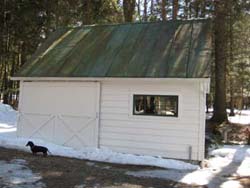How I (finally) shared a Wi-Fi connection with my neighbors

Editor's note: Don't try this at home. Sharing your Internet connection may be against your ISP's terms of service.
My neighbors in Woodstock, NY, aren’t wired for cable or DSL, so I figured I’d extend some country courtesy and wirelessly share my cable connection. But I had no idea that it would take me months to stretch my Wi-Fi signal to their house, even though it’s only a few hundred feet south of mine.
The idea seemed pretty doable. Sure, I knew there would be a hint of challenge because my garage sits right smack in between our houses, and the garage has a pitched metal roof. Metal deflects wireless signals, and I’m betting that the thicket of evergreens between our houses would do the same.
But with all the range-extending devices out there, I was pretty sure I could bridge the two houses in no time. Over the course of the winter, I have tried an array of signal-boosting tactics that include a cantenna, signal boosters, range extenders, and a variety of high-gain antennas. I managed to connect to Kevin’s PC in the house by hooking up a Hawking Hi-Gain 8dBi Directional Dish Antenna to his notebook and attaching a Hawking HiGain WiFi Signal Booster to my router. From his office, Kevin gets two to three signal bars, and speeds that are pretty decent. We were satisfied with that.
But Myoshin’s iMac sits in a stand-alone studio that’s about 40 feet further west of her house. No matter what device I attached on either end (and in the middle), I couldn’t get the signal to span the distance. A couple of weeks ago I thought I had it licked when I connected the hField Wi-Fire high-gain antenna to the iMac. The device pulled in a strong signal, but neither I nor hField’s tech support could resolve an issue with the antenna’s IP address that rendered it inoperative.
So this weekend, I swapped out my Buffalo router for a $159 Ruckus MediaFlex NG 802.11g Multimedia Router, and configured a $259 Ruckus ZoneFlex 2925 Lite Mesh Gateway as a repeater to be connected to Myoshin’s recalcitrant Mac.
First of all, setup for both devices was amazingly simple. Ruckus doesn’t ship the products with setup discs, as most router vendors do. Instead, you get a one-sheet installation guide that walks you through the very simple process. It might not be the best option for beginners, but anyone who has configured a router or two should have absolutely no problem.
The ZoneFlex 2925 can be configured as a router or a repeater, and when you connect the device the first time it gives you the option of a wizard to walk you through the settings for either. I clicked the radio button for repeater, and prepared to hunker down for at least five or six configuration steps. Instead, the device pretty much instantly configured itself, with no input from me. I trotted it over to the office, and plugged it in. Yay! The iMac was finally connected. Of course, there is some signal degradation, due to the distance, the metal roof, and the trees, but Myoshin says Web browsing is a satisfying clip faster.
So how did Ruckus succeed when other attempts failed? I’m guessing that the company’s BeamFlex technology played a big role. Ruckus says that smart-MIMO technology controls the reception of radio signals and can steer around physical obstructions (like that pesky garage roof). Another winning factor is both devices’ high-gain directional antennas, an array of intelligent devices that combine with software to find the best path and manage traffic.
This solution was a little pricier than my initial attempts, but Ruckus found a way to wend a signal around buildings and through trees. And Kevin and Myoshin, no doubt, are relieved that I’ll stop poking around their house every weekend.
